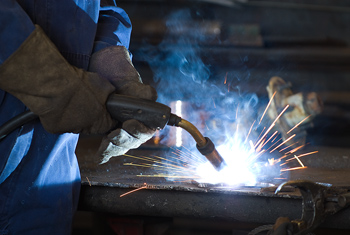How to Weld
Learning how to weld takes a lot of time and practice. A typical course in welding takes place over a few months, so don’t expect to head out to your garage and learn how to weld in a matter of hours. Still — you don’t have to attend an expensive and lengthy professional course to pick up some basic welding skills.
Learning to Weld
Welding is a process of joining two metals together. While there are many different types of welding, we’re going to focus on something called Shielded Metal Arc Welding, or SMAW. Sometimes people call SMAW welding “stick welding”, and you’ll see why in a moment. Stick welding is the most common type of welding and learning to weld in this manner is a good skill to have if you’re interested in metalworking or construction.
Welding Tips
- Gather the right materials. You’ll need a welding shield, a welding machine, an electrode holder stocked with lead, a ground clamp with lead, electrodes, and the metal you’ll be welding. Other useful items — a chipping hammer (to get rid of excess metal or “slag”) and a wire brush to help you clean up your welds.
- Put on safety gear. Make sure you have a “shade 10 or higher” welding shield to protect your eyes, a welding jacket and pants, a set of work boots, proper gloves, and safety glasses. You’re working with hot metal here, so be safe.
- Be sure to ground your metal — it is possible to connect the ground on the piece you are welding, most shops have a large metal welding workbench for grounding.
-

How to Weld
Always clean your metal before welding. Brush the surface to be welded with a wire brush.
- Now you’re ready to start welding. First, strike a welding arc. Do this by tapping the metal and quickly “striking” it like a match. What you’re doing is completing the circuit and then pulling away from it, which makes electricity jump from the electrode to the metal you’re working on.
- Ignore the bright end of the electrode and try to form a pool of molten metal. This is called a “weld pool”. To create a good pool, keep the electrode where it started for a second or two before you start moving. Otherwise you’ll make a dry weld, which is no weld at all.
- Move the weld pool across the mteal, holding your electrode at an angle just barely off 90 degrees. Moving too fast will ruin the weld — so try to use an inch of electrode for every inch of weld, easy enough to remember right? When you move your weld pool, you can opt to move in a straight line or move the electrode around in small circles. Experience will tell you which method works best.
- Keep moving the weld pool towards the end of the metal, making sure to keep a steady bead and speed while you weld.
- Once you’re satisfied with your bead, pull the electrode off your metal and let it cool for four or five seconds. Be aware that your metal is still super hot, even though it is no longer visibly or “red” hot.
- Use a wire brush to clean your weld.
